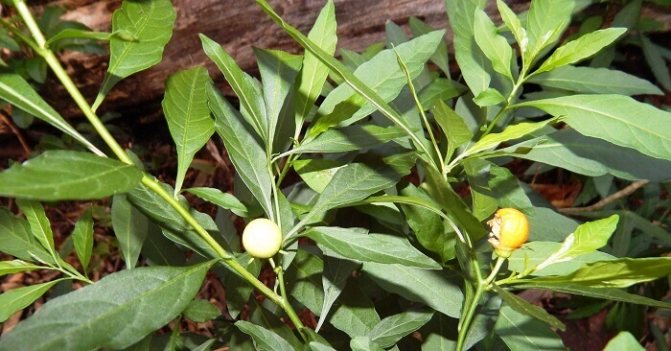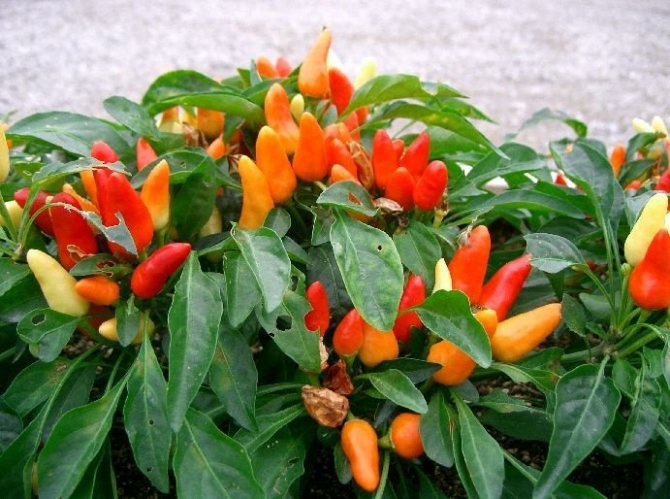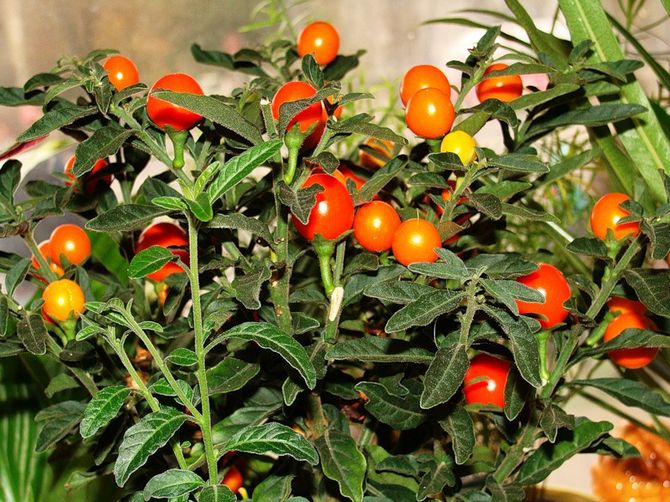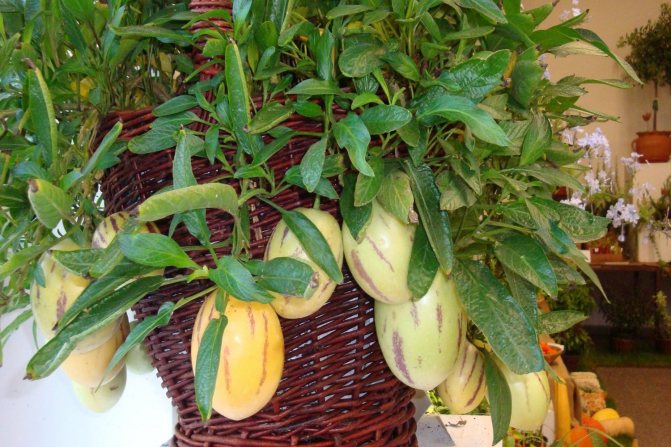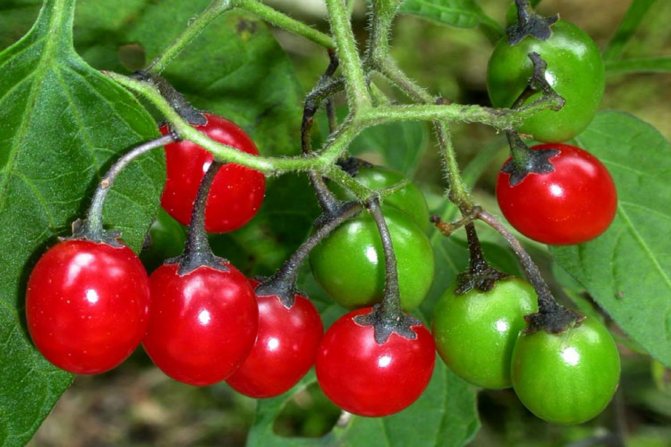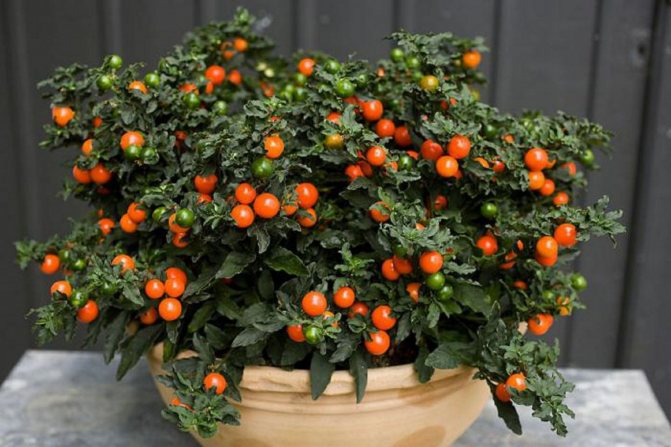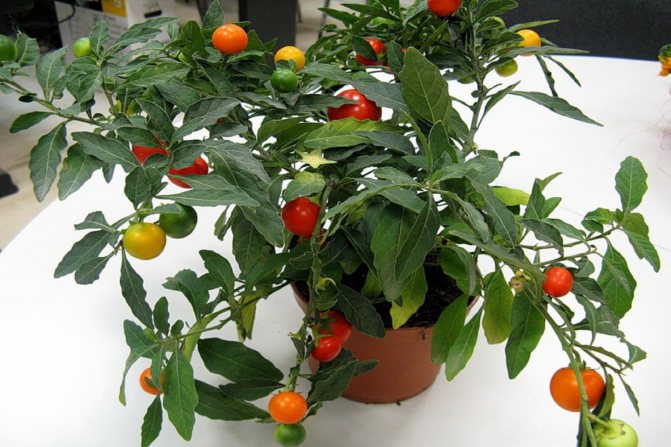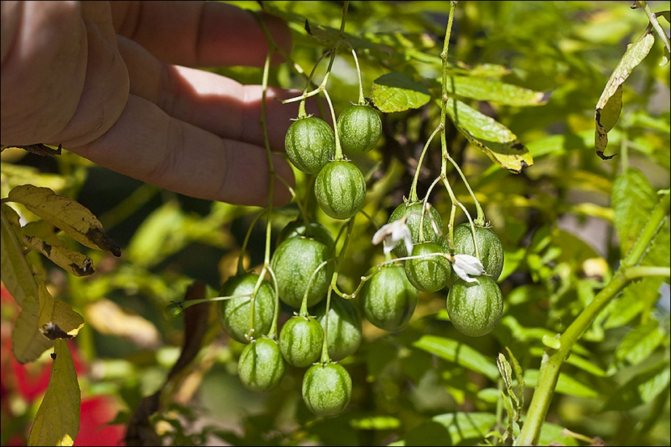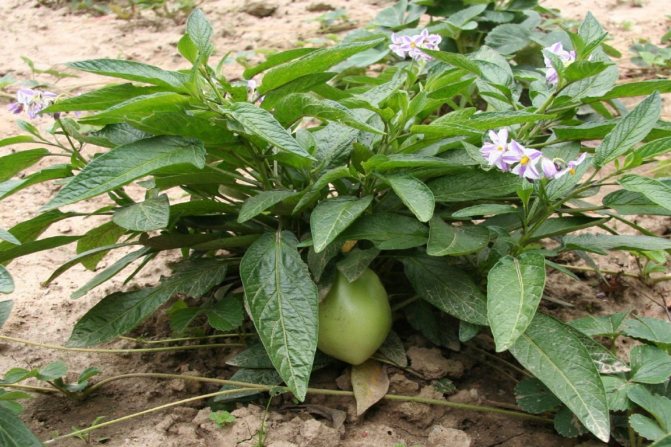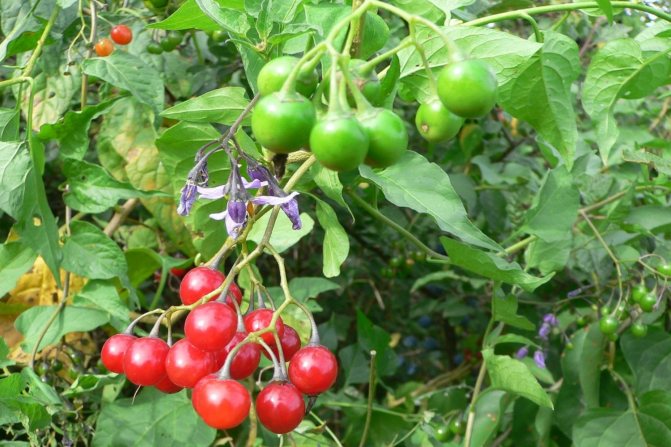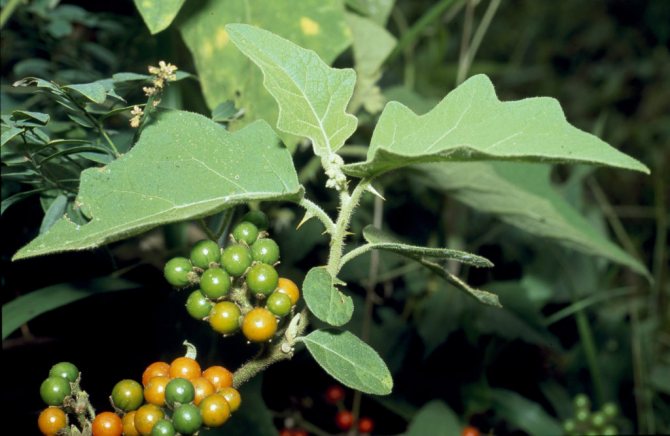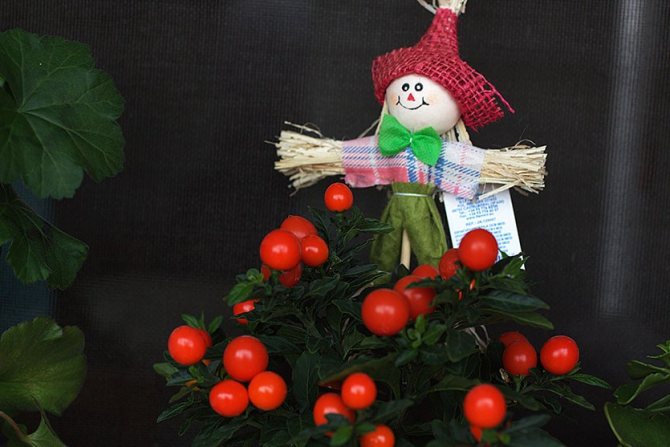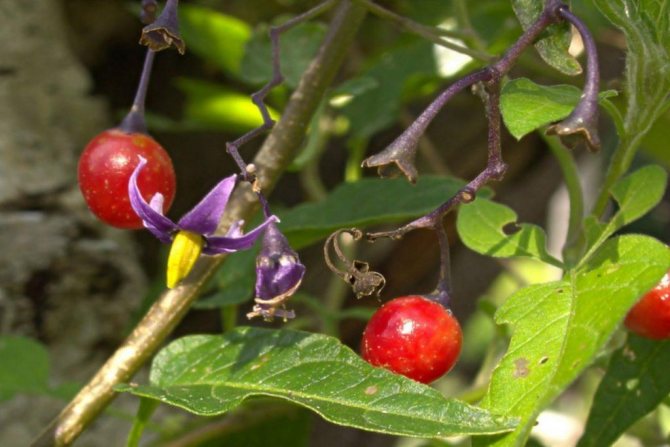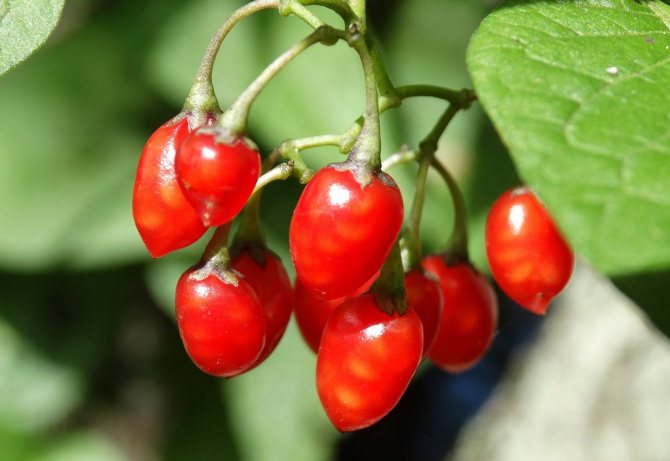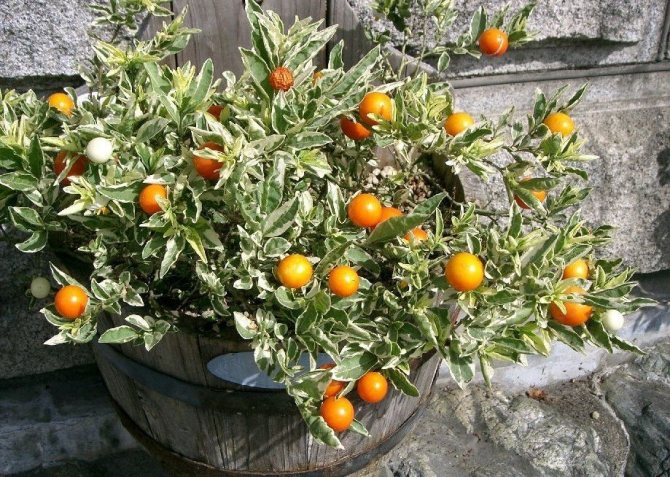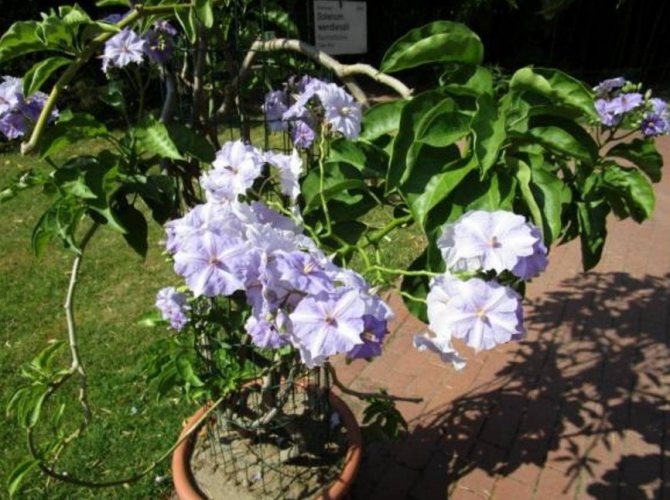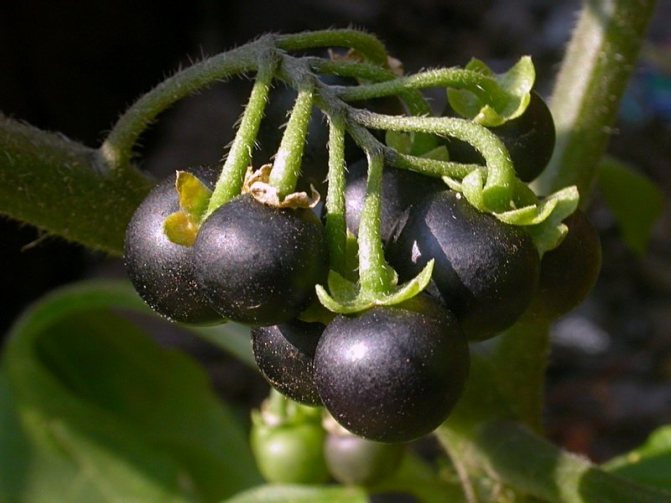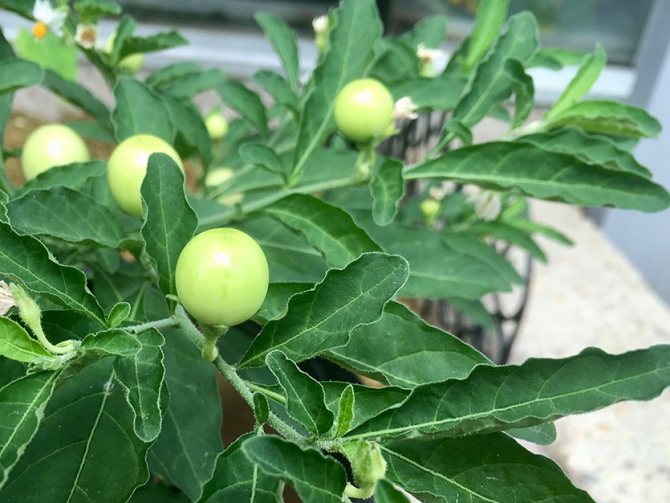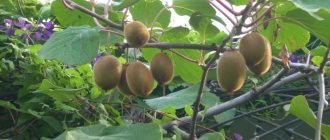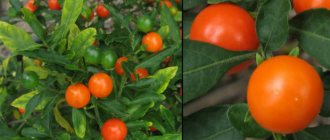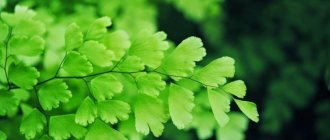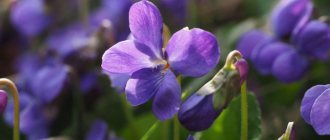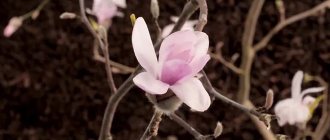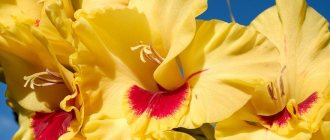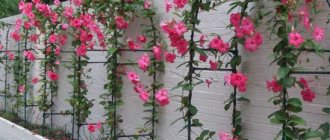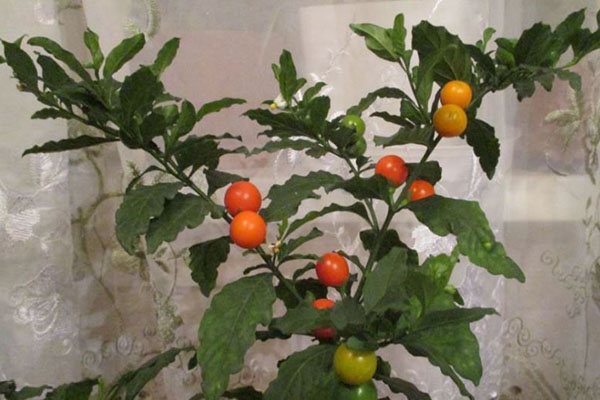
An amazing plant with which you can create an exotic green corner is indoor nightshade. Its main decoration is fruits. It is they who give the bush a chic and elegant look. The appearance of berries among the rich greenery resembles a spruce, decorated with bright balls. Why not give yourself such a cute flower and admire its beauty? Let's take a closer look at the exquisite berry mosaic on the window.
Ideal conditions for growing nightshade
Indoor nightshade is a thermophilic plant that is picky about the type of soil. But it grows best on loose, alkaline, loamy or clayey soils.
In nature, nightshade grows in tropical, subtropical and temperate areas, it is native to South America.
There are not so many care secrets - nightshade loves water and bright sunlight, but direct sunlight is contraindicated for it. The plant must be replanted annually.
The first time they do this is 2 weeks after purchase. They are transplanted into a pot 1 cm larger than the previous one in volume. Drainage is laid at the bottom, then soil is poured. A universal primer from a shop for garden and indoor crops is suitable.
Watering should be moderate in winter and plentiful on hot days. Spraying the plant loves abundant.
general information
False Nightshade is a perennial evergreen that belongs to the nightshade family. The stems branch, grow stiff over time, the plant can grow up to 50 cm in height.
Leaves are medium in size, oblong, glossy, in pairs and densely located on the branches. The flowers are formed small, resemble stars in shape, the petals are painted in a white tone.
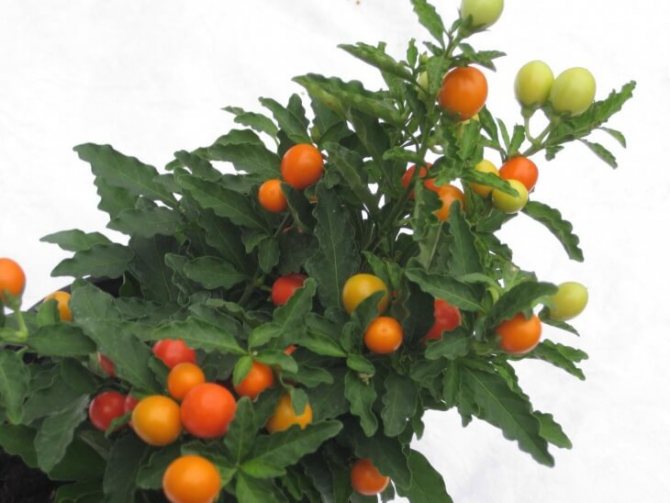

Photos nightshade
After flowering, round fruits are formed that look like cherries. According to the degree of maturation, their color changes from pale orange to red.
How to care for a flower at home
It is difficult to achieve flowering nightshade indoors. Many treat it as an annual plant for open ground, but if you know the secrets of care, you can successfully grow it for many years in a row in an apartment.
Ornamental nightshade is a fruiting plant that goes on sale since May, and its fruits are stored until winter. Then the plants are often thrown away, not knowing that they are perennials. If you provide them with wintering in a cold room, they will delight in spring or summer with abundant flowering.
The nightshade is transplanted in the spring. You can immediately give it the desired shape, since the plant responds well to a haircut. Nightshade does not tolerate drafts - during the airing of the room, it must be removed to a safe place.
Is a decorative flower dangerous for life
As the proverb says: "All that glitters is not gold." And with regard to nightshade: "not every appetizing berry is beneficial."
Solanum is highly poisonous. It is strictly forbidden to taste the berry.
Therefore, you should not keep a flower in a house where there are children. Because, even one small berry can cause poisoning... Even the juice from the leaves of the plant, getting on the skin, causes irritation. Such intoxication is especially dangerous for fragile children's immunity.
Diseases and pests - how to treat?
Nightshade can be affected by pests.
- Aphids, which settle on young shoots, are especially dangerous. For spraying, apicides are used.
- If the air is dry, a spider mite can settle on the lower part of the leaves, which can be easily spotted by the thin cobwebs on the leaves and dotted spots. He can quickly destroy the plant, from his vital activity the leaves dry out. For spraying, acaricides are used, the leaves are moistened from a spray bottle.
- Various fungal diseases can lead to rotting of the stem and leaves, the appearance of spots. Fungicides are used to treat diseased plants, and severely affected plant parts are cut and destroyed. If an unpleasant musty smell emanates from the ground, the nightshade is removed from the pot, washed the roots, cut off the rotten ones, treated with fungicide and planted in fresh soil.
Indoor nightshade: the secret of the attractiveness of the plant
In their natural environment, nightshade is most often found in regions with a warm climate. Its homeland is South America, where it reaches a meter in height. In some countries, such as Australia, the plant is being destroyed because it is considered a weed. Despite this, indoor nightshade attracts plant lovers.
The flower grows to about 30 cm. From the side it resembles a small bush. The oblong lanceolate foliage has a rich dark green color, against which clearly pronounced veins are visible. The edges of the plates are distinguished by a wavy frame, which gives the bush a spectacular look.
During the flowering period, buds appear on the branches of the indoor nightshade. They can grow in inflorescences in several pieces or singly. Interestingly, flowering takes place at different times of the warm season, but the berries appear in the winter. Their size is about 1.5 cm. Ripe color can be from bright red to orange. From the outside it looks very nice. Against the background of dark green leaves, scarlet beads shine with bright lights, which are kept on the shoots for several months. They do not wither or fall off.
Among the popular varieties of plants, the decorative indoor nightshade "Three-flowered" is especially appreciated. During the fruiting period, brushes of homogeneous berries appear on the branches, which are the decoration of the living quarters.
Possible growing problems
The appearance of the plant will tell you about the problems in growing.
Difficult to appear, most often, with improper care:
- if the nightshade is in the bright sun, its leaves will curl;
- in strong shade, the stem will stretch, and the leaves will fall off;
- with a lack of nutrients in the soil, the color of the leaves changes, if there is not enough nitrogen, they become light green;
- if after flowering no fruits are formed, the nightshade must be pollinated by yourself, transferring the pollen from flower to flower with a brush;
- with insufficient watering, the leaves dry and turn yellow;
- at high humidity or too high air temperature, nightshade sheds fruits.
It can be concluded that nightshade needs bright diffused light, regular moderate watering, top dressing and air humidity above 50%.
general description


The shrub grows to about 50 cm in height. On highly branched shoots, dark green leaves are located. Leaf shape - oval or lanceolate, slightly wavy. In length, the leaves reach 10 cm, in width - 1-2 cm.
Small white flowers, about 1 cm in diameter, star-shaped... The flowering period is almost all year round. Inflorescences are arranged singly.
In place of the flowers, small fruits appear, about 3 cm in diameter. At first, they are green in color. Then, in the process of maturation, they change it to orange and deep red. In appearance, the nightshade fruit resembles a cherry. That is why it got the name Jerusalem cherry.
On one plant, flowers bloom at the same time and fruits ripen. A large number of seeds ripen during the season. Berries taste bitter and contain toxic substances. If ingested, they cause poisoning.
You can visually familiarize yourself with False Nightshade from the photo:
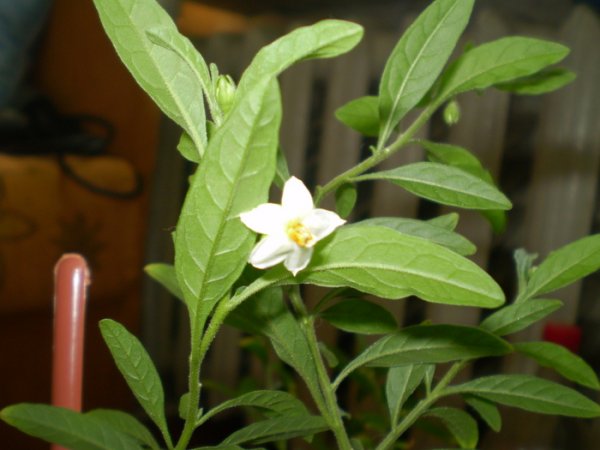

Poisonousness and medicinal properties of a flower
Nightshade flowers appear in spring or summer and look like little stars. Then berries are tied, which look very decorative. First green, then yellow, orange and red - the whole bush is strewn with colorful balls, like a Christmas tree.
But the berries of the plant are poisonous.
Their unreasonably large use can be fatal, so you need to keep nightshade away from children and animals. There are types of nightshade suitable for food, but their fruits are still rarely eaten fresh.
The plant also has healing properties. In folk medicine, dried nightshade fruits are used in the fight against angina. They are harvested from August to October. The berries should be dark, fully ripe, you cannot use green ones, because they have a lot of corned beef. The leaves of the plant are harvested from July to September, they also help in the treatment of various ailments. Fruits and leaves are dried in the fresh air, stored in boxes lined with paper.
The berries of the edible species of nightshade are dried, frozen, twisted with sugar or honey. They are used to treat epilepsy and migraine attacks. Decoctions of flowers are indicated for pulmonary diseases and catarrh of the respiratory tract. The plant is used in combination with other herbs to enhance their medicinal effects.
The nightshade, or winter cherry as it is also called, comes from a large family of over nine hundred different plants. One of the relatives of this flower is the common potato. Indoor nightshade blooms in mid-late summer, and in September beautiful berries appear on its branches, incredibly similar to cherries. As they mature, they change their color from bright green to red-orange and can hang on the branches of the plant throughout the winter, until the onset of spring thaws. These berries, although not poisonous, can cause severe stomach upset. Indoor nightshade grows well at almost any temperature. Therefore, it is grown mainly in the open air, bringing it into the room only during severe frosts.
Indoor nightshade - varieties
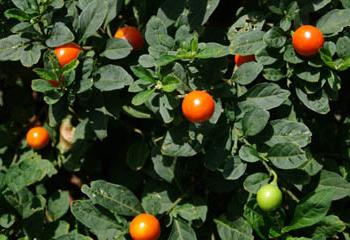

Although this plant has a wide variety of species, it is customary to grow only two of them as indoor crops. This is a pepper-shaped nightshade and a false-pepper nightshade. They are evergreen shrubs. They are very convenient to grow in a pot, which has brought the plants popularity among florists and gardeners. These types of nightshade have oval or lance-shaped leaves up to ten centimeters long. They bloom with small white flowers, which are collected in neat inflorescences. Despite the nondescriptness of their appearance, indoor nightshade amazes with the beauty of its fruits. They will fill almost all the free space between the leaves of the plant in a scattering of small beads and will delight the owner for a very long time. Even in winter, when many indoor flowers wither, nightshade continues to delight with its magnificent view. The difference between the two is minimal. Firstly, they differ slightly in the size and shape of the fruit, and, secondly, the pepper-shaped nightshade has a special silvery pubescence on young branches.
Indoor nightshade - care and maintenance
This plant is very unpretentious, but there are a couple of nuances that should be considered when caring for it. For full development, sunlight is vital for him. However, it should be remembered that indoor nightshade tolerates direct sunlight as hard as other plants.This flower prefers coolness, so you should not overheat it or keep it at a temperature exceeding +20 degrees. The plant requires abundant watering only during the period of active growth, when it needs constant delivery of trace elements and minerals contained in the soil. The rest of the time you need to water the nightshade sparingly and not very often.
What features of caring for nightshade should be borne in mind?
- It is extremely vulnerable and can be affected by spider mites due to the excessively dry air in the room. This must be carefully monitored and the flower must be regularly sprayed.
- This plant begins to bloom in the spring, therefore, it is necessary to periodically apply fertilizers for flowering plants within six months.
- The plant should be transplanted in the winter, at the end of January-beginning of February.
- Young nightshade needs to be pruned twice a year, as well as in case of falling fruits and wilting leaves, if the gardener decides to keep it for the next year.
Nightshade (solanum)
Solanum
Russian name:
Nightshade (solanum)
Common name:
Solyanum, Nightshade, Jerusalem cherry, Indoor cherry, Chinese cherry
Latin name:
Solanum
Family:
Solanaceae - Solanaceae
Homeland:
Madeira Island and South America
Plant type
: deciduous shrub
Decorative period
: all year round
Ease of growing
: For those with little experience
Lighting:
Bright light
Air humidity:
High
Purpose:
used as an ornamental fruit in a pot culture
Nightshade is a perennial evergreen dwarf tree with a lignified stem and dark green, elongated-oval leaves. Its distinctive feature is the constantly preserved decorativeness: at any time of the year, the branches are strewn with white flowers, dark green ovaries, and bright berries at the same time. A bright and luxurious bush, with a lush crown and the main decoration - bright berries-fruits, changing their color from green to bright red or orange, this is Nightshade.
Pepper nightshade or solanum was dubbed the Cuban cherry because the fruits are really very similar to cherry ones. A very beautiful family of nightshades, unfortunately, poisonous. You should probably not start this plant for those who have children in the house, from the temptation to pick and try such an attractive-looking nightshade fruit, not every adult will resist. Or you can position it so that children cannot reach it. In general, if Nightshade is not eaten, it will not cause any harm and there is nothing to be afraid of. In general, nightshade is considered an annual plant, meaning that you buy such a beautiful plant with berries in a store - like a bouquet, and after a year, after the loss of decorativeness, you throw it away. But such waste is not for us - true flower lovers :). In order to "transform" nightshade into a perennial plant, it is necessary to replant every year and cut it heavily every spring, thereby renewing the plant. When grown indoors, the nightshade flower requires special attention. The genus wears an ancient lat. the name of this plant. About 1,700 species, distributed in temperate regions and in the tropics. P. false - S. pseudocapsicum L.
Evergreen upright shrub up to 120 cm tall. Leaves up to 10 cm long., Alternate, short-petiolate, lanceolate or oval, often notched, slightly wavy, glabrous. Flowers up to 1 cm in diameter, axillary, solitary or in few-flowered racemose inflorescences, five-membered, white. Fruits are berry-like, rounded, orange-red, rarely yellow, up to 1.5 cm in diameter. Homeland - about. Madeira In cultivation since 1596, low-growing garden forms were bred.
The fruits of the nightshade are poisonous!P. pepper-shaped - S. capsicastrum.
A species generally similar to the previous one, but distinguished by its smaller size, less lignification of the stems, grayish pubescence of young shoots, formed by small stellate hairs, and not so large (less than 1.2 cm in diameter) fruits.Homeland - South Brazil and Uruguay. Grows in forests. Garden forms are known: "Variegatum" - with variegated leaves, "Craigii" - with white and red fruits. This nightshade is popularly called "Angina tree". Because an infusion of dried fruits is a very effective remedy for pain with sore throat. The infusion is prepared as follows: 1 tablespoon of crushed dry berries to insist for 2 hours in a glass of boiling water. Gargle with this infusion 3-4 times a day.
Nightshade care
Location
The location is bright to sunny, well ventilated. In the summer, the plant is taken out into the fresh air. Plants are kept in winter at a temperature of 14-16 degrees. At higher temperatures in winter, the plant requires frequent irrigation. If it is decided to keep the plant until next year, it should be pruned after the fruit has fallen and the leaves have wither.
Humidity
Moderate humidity should be constantly observed, it needs constant spraying. In summer, plants need a lot of water, in winter, water sparingly, but do not overdry. In summer, this can lead to falling flowers.
Top dressing
Since nightshade constantly spends nutrients for the formation of flowers and fruits, it is fed weekly with liquid flower fertilizer, in winter, this is done much less often (once every 4-6 weeks).
Bush formation
For a plant to have a compact crown with dense foliage, it must be formed. As soon as it reaches 25-30 cm in height, the main stem is shortened by a quarter, and as the shoots of the second and third orders grow, their ends are pinched.
Transplant nightshade
Transplanting nightshade in combination with pruning, transplanting is done annually. At the end of winter, the stems are cut to half the height. Until spring, they are almost not watered, then transplanted. In the summer, the pot is exposed to fresh air, during the flowering period it is treated with an insecticide. In the fall, they bring it back into the room.
Breeding nightshade
Reproduction: Propagated in the spring by seeds, cuttings. It is better to buy the plant already in fruit. The nightshade is easily propagated by green shoots and freshly harvested seeds that can be sown year round. True, they note that the plants of March sowing develop best of all. Seedlings appear in two weeks, and in the phase of the third or fourth leaf, the seedlings dive into pots with a capacity of 0.5 liters. Good drainage is essential, as the plant does not tolerate stagnant water. Solyanum also suffers from overdrying the substrate, so the soil must be sufficiently water-absorbing. A mixture of turf, peat, humus and sand (1: 1: 1: 0.5) will be ideal for a plant. Sowing begins in March. Seedlings appear at a soil temperature of about 18 degrees. Seedlings are pinched 1-2 times for better branching. Climbing species and large shrubs are propagated by cuttings, which take root at a soil temperature of 20 degrees and high humidity.
Flowering and fruiting nightshade
This wonderful plant blooms in spring, the flowers are inconspicuous, small. The main beauty appears after flowering, wonderful fruits of bright red, orange, yellow look extremely elegant! Fruiting lasts a very long time, until the beginning of winter, the fruits of the Nightshade can persist until January and even February, so the rest period of the plant from flowering or fruiting is very short.
Protection of nightshade from diseases and pests
Nightshade species are often damaged by greenhouse aphids and whiteflies. For prevention, it is necessary to provide a ventilated, not too warm room. Regular monitoring is required. If a disease is detected, the plant is sprayed with actellic solution, it is also necessary to pick up all damaged leaves and flowers.
Features of growing nightshade
A feature of the unpretentious indoor nightshade is the rapid development of the bush and the beginning of flowering from a young age.The nightshade grows quickly enough, it sets fruit well, if you try to make artificial pollination, in the natural environment in the fresh air. At the end of winter, it is imperative to carry out pruning followed by transplantation, and in the fall - to pinch the tips of those shoots that do not bloom. Although pepper nightshade is considered a purely ornamental plant, there is information about its medicinal properties. Healers claim that ripe fruits can be used to prepare an effective drug for the treatment of angina. A tablespoon of crushed dry berries is insisted for two hours in a glass of boiling water and gargled with this infusion three to four times a day. Drinking the composition is not recommended. You cannot eat the fruits of the Cuban cherry. They are believed to be poisonous and, although not fatal, can cause temporary stomach upset, especially in young children.
Nightshade belongs to such ornamental plants that do not like loneliness. And it will be very difficult for him if he does not feel a caring heart next to him. Give him your care, but he will not remain in debt!
Nightshade or solanum (Solanum) is a genus of plants in the Solanaceae family. The genus unites more than a thousand species. These are grasses, shrubs and even trees that are common in warm and temperate climates around the world. South America is considered the homeland of most species. It was from there that the well-known representatives of the genus came - potatoes, eggplants, tomatoes.
Several species are grown in room culture, of which the most famous is Solanum pseudocapsicum. The homeland of this species is Peru, Ecuador, the island of Madeira. Under natural conditions, it grows in many countries of the world, and in Australia, where it was introduced several centuries ago, it has become a weed that is difficult to control. This suggests that Pseudo-Pepper nightshade is a very unpretentious plant.
Indoor nightshade is a low evergreen shrub. In nature, it can be up to one meter high, at home it is more compact. The leaves of the nightshade are lanceolate, slightly wavy. Their petioles are short, the color of the leaves is dark green.
The flowers are white, small, solitary or collected in small racemose inflorescences. It blooms at any time of the year. But flowers are not the decoration of this plant. The main charm of decorative nightshade is its fruits. The fruit of the false-pepper nightshade is a rounded berry, 1-1.5 cm in diameter, bright orange or red. The berries stay on the plant for a long time, decorating the bushes in the cold season. To keep the fruit on the plant longer, keep the nightshade in a cool place.
Dwarf forms of indoor nightshade are especially popular. They grow no more than 30 cm, the bushes are lush, strewn with numerous berries. This is a completely non-capricious plant, it can be found in any flower shop. Most often they are sold in winter. At this time of year, along with and, it is one of the most spectacular indoor plants.
Nightshade wintering in middle and temperate latitudes
Bittersweet nightshade
Otherwise, the "wolfberry" is a semi-shrub, the branches of which spread along the surface of the earth and are able to grow vertically on a support. Under various conditions, the height of the plant can be from 40 to 190 cm. Large, bright flowers of this species are collected in racemose inflorescences that droop downward.
Flowering lasts from May to August. After that, bright red berries are formed.
Due to its decorative effect, which pleases the eye at first with long flowering, and then with bright numerous berries, bittersweet nightshade is widespread among gardeners, although this species is found in the wild almost throughout Russia.
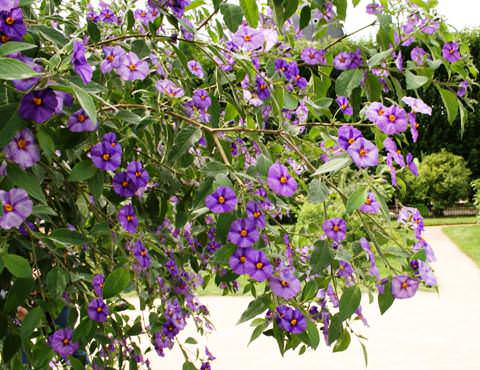

The plant perfectly tolerates shade, does not need bright lighting. Prefers acidic soils with high humidity. Damp spots are the perfect spot for a bittersweet nightshade.She does not need shelter for the winter, just as she does not need to be removed from the support. The bushes are formed in the spring with the help of partial pruning of the branches.
The plant propagates by seeds and branches. It is enough in the spring to put the stem layering on the ground, sprinkling it with soil a little. In autumn, the branch can be separated from the mother plant and transplanted.
Seeds are sown in open ground before winter. This process does not require any special conditions. Shoots will appear in the spring, and in the fall, young plants can be planted in a permanent place of growth.
Black nightshade or "ordinary"
It is an annual herb. The stems rarely reach a height of one meter. It is often found as a weed in vegetable gardens. But because of the beautiful white inflorescences that delight the eye with long flowering, it is also used in cultivation.
Bright berries begin to ripen in July. Sowing for seedlings is carried out in mid-April, dive seedlings are planted in the ground at the end of May. This type of vine prefers a fairly moist soil. Shade tolerates well. Group plantings of black nightshade create an unusual hedge that attracts attention with beautiful flowers and berries.
Is indoor nightshade dangerous?
All parts of the nightshade are poisonous. It is especially dangerous to eat its fruits. They taste bitter, so no one will just eat them. This plant is only dangerous for young children. They are hard to resist the temptation to taste the bright orange berry. A child will not eat many of these fruits - they taste unpleasant. But digestive upset can get! In addition, there are cases when babies swallowed berries whole or they got into the respiratory tract.
Lighting
... The nightshade is a light-loving plant. Prefers diffused light. In the shade, nightshade almost does not bloom, stretches out and loses its decorative effect. In winter and autumn, it is better to keep it on the southern window; from mid-spring it is advisable to shade it from direct sunlight. In summer, the best place for nightshade is a balcony or veranda.
Temperature
... In summer, nightshade grows well at normal room temperature, does not like heat, it is useful for changes in night and day temperatures. In winter, it is recommended to reduce the temperature to 12-15 ° C. In cooler conditions, the berries stay on the branches for longer. In summer, the plant is too hot on the south window.
Watering
... Decorative nightshade is watered regularly and abundantly during the period of active growth and fruiting. In winter, watering is reduced to moderate, the cooler it is in the room, the less moisture is required. But at the same time, you cannot overdry the earthen lump. It is useful to spray with lukewarm water.
Fertilizer
... Additional nutrients are required for the formation of flowers and fruits. Twice a month, fertilized with complex fertilizers for flowering plants in spring and summer. In winter, you may not fertilize or feed with a half dose once a month.
Pruning
... Nightshade tolerates pruning well. It is carried out after fruiting in order to preserve the decorative effect of the bush. At the end of winter, the plant often turns yellow and leaves fall off. Pruning has a beneficial effect on the health of the plant. First of all, the main stem is shortened to stimulate the growth of the side branches. Then pinch their ends.
Transfer
... It is better to transplant an indoor nightshade in early spring before growth begins. The substrate should be loose, breathable. In the pot, be sure to pour a layer of expanded clay or other drainage material so that excess water flows freely. The nightshade is heavily pruned (by about a third) and transplanted into fresh soil.
Nightshade is not considered a long-lived plant. It grows rather quickly and loses its decorative effect. Many growers prefer not to replant old plants, but to re-root the cuttings.
The soil
... A mixture for transplanting nightshade can be taken as follows: sod, peat, humus soil mixed with sand in a ratio of 1: 1: 2: 1.
Fruiting
... Sometimes it happens that nightshade blooms, but the berries are not tied. If the bush is on the balcony, then a light breeze carries pollen freely. In the room, it is advisable to pollinate the flowers with a soft brush.
Diseases and pests
... In a dry and hot room, nightshade can be affected by spider mites. To combat it, it is necessary to regularly spray the plant and apply acaricidal agents to treat the affected areas.
Often, pests are found when the pots are moved from the garden back to the house. In summer, aphids appear on the plant. Bushes must be treated with insecticides for prevention.
Reproduction
... Propagated by indoor nightshade seeds and cuttings. It is easier to propagate by seeds. They are sown themselves when ripe berries fall, if the pot is wide enough. Young plants are dug up and planted in separate pots.
The seeds can be collected and sown in the spring in a wide container. They are not buried in the soil, but simply laid out on the surface and lightly sprinkled with sand. Germinated at a temperature of 20-22 ° C under a film. Seedlings by
In spring and summer, it can be propagated by cuttings that root well in a mixture of equal parts of peat soil and sand. Cuttings are taken with 2-4 leaves, rooted under a film. For better branching, young plants are pruned several times during the summer.
Indoor nightshade is a wonderful decoration for any room. It is a small shrub plant with beautiful flowers and ovaries. The trunk of the plant is lignified, the leaves are elongated, small. With proper care, indoor nightshade will bloom all year round and then set fruit. The plant has several names: not only nightshade (solanium), but also Jerusalem or Cuban cherry.
Is homemade nightshade a danger?
Any part of the nightshade is poisonous. In no case should you eat berries. They taste unpleasant, bitter, but small children can eat them out of curiosity. Despite the fact that they most likely will not eat a large amount of these fruits, they will most likely have indigestion. And it also happened that the child swallowed the fetus whole or thrust it into the respiratory tract.
Indoor nightshade is a dangerous plant, and it is not advised to grow it in the apartment where there are small children, it would be better to wait until they grow up.
Plant care
Some people are puzzled by the care of indoor nightshade, but if you follow all the necessary requirements, the plant will grow beautifully and delight with its beauty.
In order for the bush to grow well and bear fruit, the following conditions are necessary:
- Correct temperature. The room where the nightshade grows should have a temperature of 20 to 25 degrees. In winter, the temperature drops to 15 degrees. If you do not adhere to the temperature regime, then the foliage of the plant begins to turn yellow and fall off.
- Lighting. Indoor nightshade is a plant that prefers bright spots, but without direct sunlight. With a lack of light, it bears bad fruit, immediately drops the foliage. This tropical plant is afraid of drafts, so it is advised to place it away from loggias, balconies and other places where doors and windows are often opened. Drafts are especially terrible in winter.
- Watering rules. During the growth period, the bush needs a lot of water, therefore it must be watered abundantly. Some recommend additional spraying of the plant. Only warm, settled water is used for irrigation. In winter, it is necessary to reduce watering: the soil is moistened only as it dries.
- Top dressing. Indoor nightshade in home care requires regular fertilizing. He needs a sufficient amount of nutrients. It is recommended to apply fertilizers during flowering and fruiting. For this, complex fertilizers are used for flowering plants.These can be purchased at any flower shop. After the nightshade has faded, the dressing is reduced, and in the winter period it is completely stopped to make.
In warmer months, the plant can be taken out onto a balcony or terrace. In the open air, it grows and develops better, gives more flowers.
How to fertilize nightshade
It is very important to regularly feed the plant to ensure effective flowering and mass fruiting.
In the spring and summer, apply fertilizer with watering once a week. If necessary, fertilize the plant no more than once a month during the cold season. Complex mineral fertilizers or special fertilizers for nightshade vegetable crops (for example, for tomatoes and peppers) are suitable for nightshade. During the growing season, any complex designed for flowering plants is also perfect. It is advisable to slightly reduce the recommended dosage.
Transplant features
The plant is transplanted every year during the dormant period: the best time is the end of February. For this, a light and nutritious substrate is prepared. It must be breathable. A pot of a larger size must be selected than the previous one. For transplanting, use a special soil for tomatoes and peppers.
During transplantation, the plant is pruned. All branches are removed on it up to half the height, and all lateral shoots are cut off so as to form a beautiful bush.
The next pruning is done in June to stimulate branching.
Transplant and soil for nightshade
Transplanting nightshade is carried out annually for young bushes, adult plants are transplanted every three years. Before transplanting, the plant is pruned. A nutritious substrate is prepared for nightshade, two options are possible:
- Peat, turf and leaf land in equal proportions;
- Peat, humus, sand and sod land (2: 2: 1: 2).
The nightshade pot when transplanting should be spacious for the plant's root system. Lay drainage (expanded clay, pebbles) at the bottom. After planting, the plant is watered, you can fertilize it in two weeks.
Breeding methods
Reproduction of indoor nightshade is possible in two ways: sowing seeds and cuttings. The first method is considered to be the simplest.
Seeds are harvested from ripe fruits, you can also let them germinate on their own. This happens after the fruits wither, which fall to the ground and, after lying for a while, sprout. Young plants are carefully dug up and transplanted into separate containers.
To collect the seeds, medium-sized fruits are selected. Seeds are extracted from them, washed in a pink solution of potassium permanganate, and then dried. Seeds are sown in spring in pots with prepared soil. You can make it yourself, or you can buy a ready-made mixture for peppers and tomatoes.
Seeds are sown to a depth of 0.5-1 cm. Containers with crops are placed in a warm, bright place. It is important to ensure that the topsoil does not dry out. After about two weeks, the first shoots appear. After they have two real leaves, they carry out the first pick, and after about a month - the second.
Can be propagated by nightshade and cuttings. To do this, cut branches are placed in water or immediately planted in the ground. In the latter case, it is necessary to put the plant in a mini greenhouse. You can propagate nightshade by cuttings not only in spring, but also in summer and autumn. In winter, nightshade sleeps and is not propagated by cuttings.
Growing from seeds
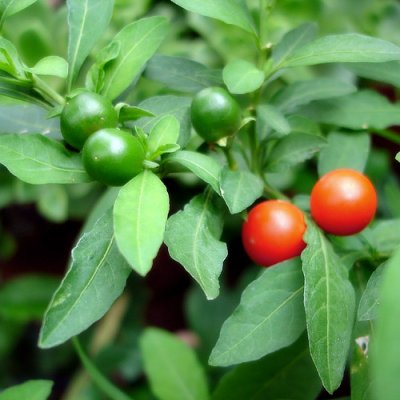

For germination of seeds, leafy soil is used, which is poured into a seedling box with a layer of 10 cm.
Seeds are laid out on the surface at a distance of 2-3 cm.On top they are sprinkled with a layer of sand about 1-1.5 cm.
The seedling box is covered with foil and placed in warm a room with a temperature of 21-23 degrees.
Periodically, the film must be lifted and the surface must be sprayed from the spray gun. Seedlings will appear in 10-14 days. After the appearance of 2-4 leaves, dive into separate pots.
Reproduction
After pruning the plant in spring, you can select the strongest cuttings and root them. To do this, they are placed in a container with water. You can immediately plant the cutting in a separate pot with prepared soil and moisten the soil well.
Caution, children!
Indoor nightshade is considered a poisonous plant. If the family has small children, then it is better to refuse to grow it or place the pot so that the child cannot reach it. Bright berries attract to themselves, and kids always want to touch them, pick and taste them. In no case should this be allowed!
Some pets also like to bite off a leaf. To prevent this from happening, it is best to keep the plant in offices, in a winter garden, where animals, and, especially, children cannot get.
Application
False-pepper nightshade is used only as an ornamental plant. In spring and summer, it is a compact, leafy shrub with delicate flowers. At the end of summer, the fruits that are formed and ripening give the plant the appearance of a Christmas tree. Many red and orange berries cover the bush. The red giant nightshade looks especially decorative.
The plant looks great both on the windowsill in the apartment, and in the greenhouse or winter garden. Such a bush will decorate any office space.
It is easy to grow false nightshade at home. This is an unpretentious plant that is resistant to diseases. Its only drawback is the toxicity of fruits and leaves, which can be dangerous for children and animals.
Attention super FLY!
Houseplants
Interesting to read:
- Special conditions for growing pepper nightshade
- Decorative spurge, reproduction and care of it
- Purslane - a colorful carpet of flowers in a flower bed
- Clematis of Tangut: how is growing from seeds?
- Zamioculcas - a living plant with waxy leaves, reproduction, care, application
- Point bell - care and reproduction
- How codiaum reproduces: main characteristics
- Planting and caring for Heychera: possible diseases
- How to plant a violet: basic tips and tricks for planting and care
Plant pests and diseases
Indoor nightshade needs protection from pests and diseases.
The main pests are aphids and whiteflies. To avoid trouble, you need to constantly monitor the condition of the leaves. In case of defeat, treatment with special preparations is used. You can purchase any pest remedy that is available in the store. Be sure to find an indication that it could be used at home.
The plant is practically not affected by diseases, with the exception of the black leg of the seedlings. Most often, fasting occurs due to lack of nutrition. This is evidenced by the change in the color of the leaves.
Popular plant species
For decorative use and growing at home, there are only a few types of solanum. The most common:
- Pseudo-transverse... Low shrub, densely covered with small oblong leaves. This species grows up to 40-50 cm. It reaches the peak of its beauty in late autumn, when the bush is densely dotted with fruits. It is he who can often be seen on the shelves of flower shops, on New Year's Eve. In such a bright and attractive form, the flower will last all winter.
- Pepper... The species is slightly different from its relative. It is slightly smaller in stature, and not so densely covered with fruits. But on the other hand, its shoots are decorated with an attractive velvety cover, of a bluish tint. Unlike its relative, the flower is not at all poisonous, but on the contrary, it has medicinal properties. The dried fruits of this nightshade are used to treat throat ailments. Therefore, the people also call him "antianginnik".
- Jasmine... It has obvious differences from its two previous relatives. It looks a lot like a vine. Its main aesthetic value is delicate white or light blue flowers. The inflorescences consist of 5 oblong petals.The leaves are also oblong. This flower reaches 1.5 m in length.
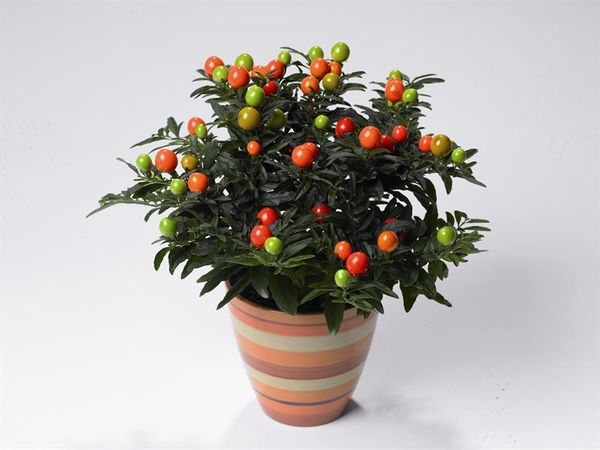

Pseudo-transverse
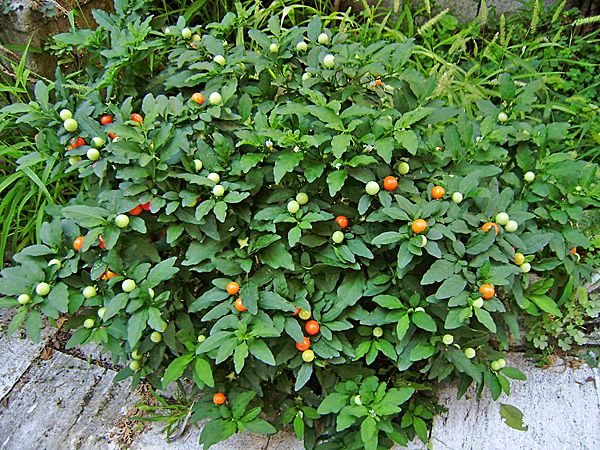

Pepper
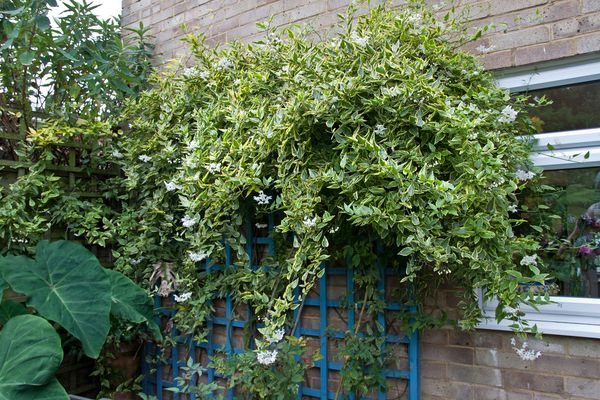

Jasmine
Growing difficulties
Let's talk about proper care for indoor nightshade. How to look after and how to avoid possible problems, further in the article.
- Lack of fruiting. With a lack of pollination, the plant does not set fruit well or is completely absent. If the plant is not exposed to the open air, then manual pollination is recommended. To do this, take a soft brush and use it to transfer pollen from one flower to another. These actions are performed several times.
- The plant sheds berries and leaves. This can be triggered by drafts, sudden temperature changes, and heat. To eliminate troubles, it is necessary to change the habitat of the plant.
There are no other difficulties with growing. If you follow all the recommendations, the nightshade grows into a beautiful lush bush with abundant berries.
Photo
You can visually familiarize yourself with False Nightshade from the photo:
Benefit and harm
Some species of nightshade are poisonous. Even a small amount of substances contained in berries can lead to severe poisoning. This usually results in an upset stomach, and at high concentrations, severe poisoning.
Other plant species have beneficial properties. Their leaves and fruits contain many vitamins, acids and other substances. All of them actively fight bronchitis, sore throat, promote wound healing. Nightshade infusions have anthelmintic and diuretic effects.
Subject to the rules of care, this plant will become a real find for those who like beautiful plants that require minimal care. For proper care, timely feeding and regular watering, the plant will respond with abundant flowering and a large number of fruits.
The poisonousness of nightshade
The green nightshade berry contains steroid glycosides - substances poisonous to the human body. As it ripens, according to scientists, the berry is less poisonous, but there are cases of fatal poisoning. So an adorable homemade flower with red berries can be dangerous.
Attention! Keep nightshade out of the reach of children and pets. Both are curious, and the red berries are so beautiful, so beckon to try.
Eating nightshade berries can cause severe poisoning. The toxins they contain irritate the stomach lining and are absorbed into the bloodstream. Poisoning symptoms:
- Heart palpitations and respiratory system failures;
- Impaired coordination of movement and hearing loss;
- Dilation of the pupils;
- Vomiting and pain in the gastrointestinal tract.
All these symptoms clearly indicate that nightshade is poisonous. At the first sign, it is necessary to flush the stomach with a weak solution of potassium permanganate with the addition of activated carbon. Even after successful irrigation, the patient must be shown to the doctor.
Breeding options
There are two ways to breed nightshade:
- From seeds. In this case, the bushes will be well-formed and strong;
- By cuttings. This method requires more time for rooting and adaptation of the plant in the new soil.
Depending on the planting option, the fruits on the bush can be both abundant and large, and vice versa.
To grow indoor solanaceous bushes from seeds, you need:
In order to further form a beautiful voluminous nightshade bush, seedlings that have reached a height of ten centimeters must be pinned and side shoots removed. Thus, the growing indoor shrub will take on a spherical shape.
Poisonous or not
Indoor nightshade is a poisonous plant. All parts of the bush are dangerous: berries, leaves and shoots.
Nightshade is not recommended for growing in apartments with small children. The bright colors of the berries can attract a child.
Can you eat berries?
Eating indoor nightshade berries can lead to a serious eating disorder.At high doses, a lethal outcome is possible.
However, there are certain types of nightshade, the ripe fruits of which can be used as a medicine. For these purposes, the fruits are dried, frozen or ground with sugar.
Unripe nightshade fruits are especially dangerous. These berries contain a lot of harmful substances - solanine.
Indoor nightshade is a beautiful and unpretentious houseplant that a novice florist can handle. Care must be taken to plant nightshade in a house with small children, as fruits and leaves contain toxic substances.
Read other interesting articles on the site, for example about: nertera, muhlenbeckia, irezine, heptapleurum and hypoestes.
Description of the plant and its varieties
Which is found on the windowsills of lovers, in natural conditions can be found in Madeira, in Peru, in Ecuador. There are about 1700 members of the family. For decorative purposes, only a few species are grown. A common indoor variety is false-pepper nightshade.
The perennial looks like this:
Advice. In order for the fruits to last longer, the bush should be kept cool.
In addition to the described type, the rooms contain:
- Curly nightshade with thin, curly stems. Purple flowers in the form of stars.
Curly
- Jasmine nightshade. Climbing shrub shoots, without edge. The leaves located below are trifoliate, shiny. The plates at the top of the stems are simple, ovoid. The flowers are white with a blue tint.
Jasmine
- Nightshade Rantonetti. A shrub is often formed with a stem. In summer and autumn, the plant is densely covered with purple flowers with a yellow center.
Rantonetti
The listed varieties are distinguished by their unpretentiousness, rapid growth and high decorativeness.
Features of care in summer and winter
Indoor nightshade is unpretentious, although it also requires some attention. Its care varies with the season.
Location
If you want the nightshade to delight with flowering, you will have to find a place for it with good lighting. In the shade, it loses its spherical shape, sophistication and is too stretched. Diffused light is ideal.
Winter. In winter and autumn, the flower is placed on the southern windowsills.
Summer. Since mid-April, the Solyanum are shaded so that the solar radiation is not too intense. You can place the pot on the balcony. In summer, in country houses, nightshade is taken out on the veranda.
Temperature regime
Winter. In the cold season, nightshade loves temperatures of 13-15C. With this mode, the flower will delight the owner with berries longer.
Summer. In the summer season, the plant is comfortable at standard room temperature. Constant heat does not tolerate well. If possible, nightshade is exposed to fresh air.
Watering
At any time, a slightly moist soil is maintained for Solyanum, excluding the formation of a "swamp".
Winter. In the cold season, moderate watering is provided. The lower the air temperature, the slower the soil dries.
Summer. When it is hot or the plant is bearing fruit, it is watered generously. Nightshade is very fond of spraying with warm water. The procedure is especially relevant in spring and summer.
Top dressing
Winter. In winter, the flower is fed with a half portion of fertilizer at monthly intervals or not fed at all.
Summer. If you want to see a nightshade in bloom, you have to fertilize it. In the summer, the flower should be fed twice a month. Purchase a fertilizer designed for the flowering period.
Pruning
Nightshade is a plant that periodically requires pruning. Without this procedure, it loses its beautiful shape. Pruning is necessary in late spring and early summer, when the leaves of the plant turn yellow. To spur the growth of lateral shoots, pinch their ends and the main stem.
Transfer
The optimal time for transplanting a flower is from the beginning of spring to the beginning of active growth. Before the procedure, the salt is cut by a third.Provide the seedling with loose soil where oxygen will pass well. Do not forget to put drainage at the bottom.
It should be borne in mind that a houseplant with orange berries quickly loses its decorative appearance. Therefore, flower growers prefer not to transplant it, but to separate new cuttings.
A smart approach to caring for indoor nightshade
Since the plant came to Europe from tropical countries, its conditions must correspond to its natural habitat. A reasonable approach to caring for indoor nightshade at home leads to a remarkable result. Exotic berries will become an exquisite decoration of the living space, turning it into an oasis of peace and pleasure.
The basic rules of care are to create suitable conditions for the culture, which include:
- lighting;
- humidity;
- temperature regime;
- watering;
- top dressing.
Let's consider in detail each procedure to grow an exotic flower at home.
Adequate amount of light
Practice shows that proper lighting directly affects the decorativeness of the nightshade. Throughout the season, the plant needs diffused light. Therefore, it is placed on windows facing east or west. When winter comes, the flower feels wonderful on the south side. With insufficient light, nightshade develops poorly and bears a small amount of fruit.
Reasonable temperature and humidity control
For the successful development of a tropical plant indoors, it is necessary to maintain an optimal temperature regime. In spring and summer, it is in the range from 18 to 25 ° C, and in winter 12 or 15 ° C is allowed. If the temperature regime is violated, the flower will lose all berries and foliage. This is one of the reasons why nightshade leaves fall at the most inopportune moment.
The plant does not like drafts, therefore, when airing the room, it is better to remove the culture pots to another place.
Since nightshade is native to the tropics, it needs regular spraying. Also, the pot with the culture can be placed in a shallow pan with moistened drainage material. The main thing is that there is no direct contact with water. Insufficient air humidity has a detrimental effect on the development of culture. Therefore, gradually losing vitality, nightshade dries up and may eventually die.
A wise approach to watering
During intensive development, in spring and summer, the plant especially needs moisture. As soon as the topsoil dries up, and this happens quite quickly, it must be watered immediately. With the onset of autumn, and then winter, the amount of watering is reduced. As a result, the bush will always decorate the living space.
For irrigation, it is advisable to use settled water at about room temperature.
Reliable beauty stimulant - top dressing
If a person stops eating, the first thing from his face is beauty. Likewise, a tropical guest will not be able to bear fruit abundantly without feeding. For feeding, you can use liquid fertilizers of a complex nature. They are brought in once every 14 days during the period of fruit formation or vegetation. After the formation of berries, top dressing is applied once a month.
Ardisia crenata (Ardisia crenata) and her photo
The most common species is Ardisia crenata. It can grow up to two meters, and its bright red fruits can be on the plant for even more than one year. The leaves have a dark green hue, which attracts our eyes. Ardisia crenate grows in the subtropical forest areas of China, on the territory of Korea, the islands of Japan and in India almost everywhere.
Ardisia crenate plant is a small plant up to one meter high, with branches in the form of tiers.
This species has a very dense crown of leaves. It is also decorated with wreaths of berries, which are at the base.If the plant is placed in a pot, where it will be a little cramped, then, oddly enough, it will give color and fruit much better. Look at the photo of Ardisia crenate:
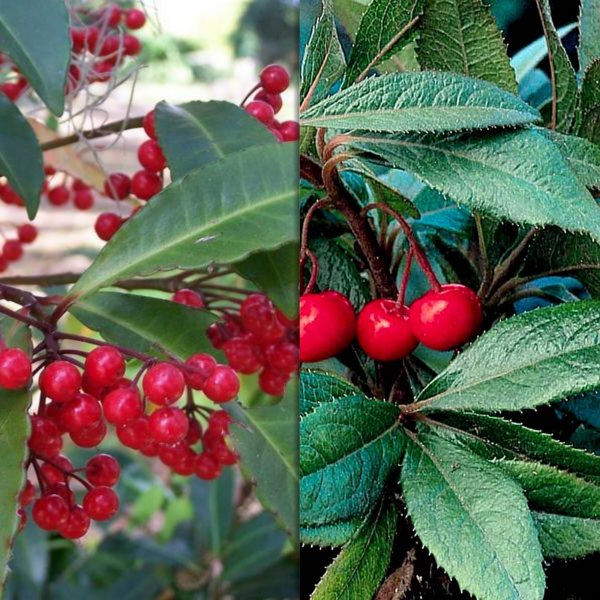

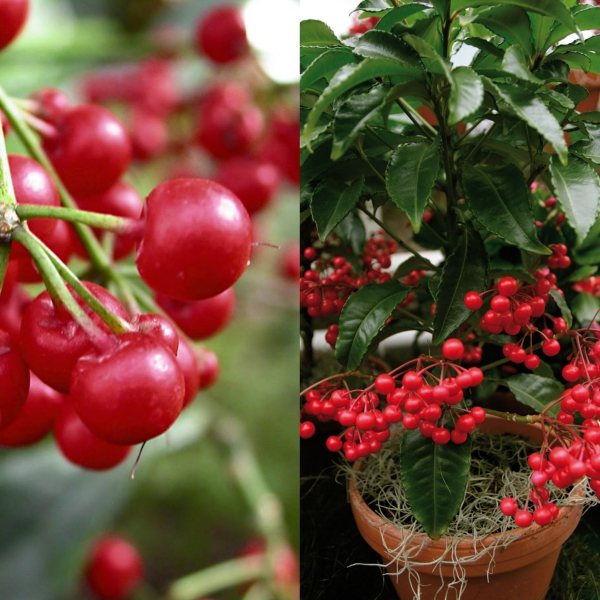

In the spring or summer period, small and not very pronounced, but fragrant, white flowers with a shade of pink appear.
A short period of time after the appearance of flowers on ardisia crenate, a rounded drupe begins to be seen. Initially, they have a light orange tint, and by autumn they acquire a light red color.
To date, varieties with white and pink berries have also been bred.
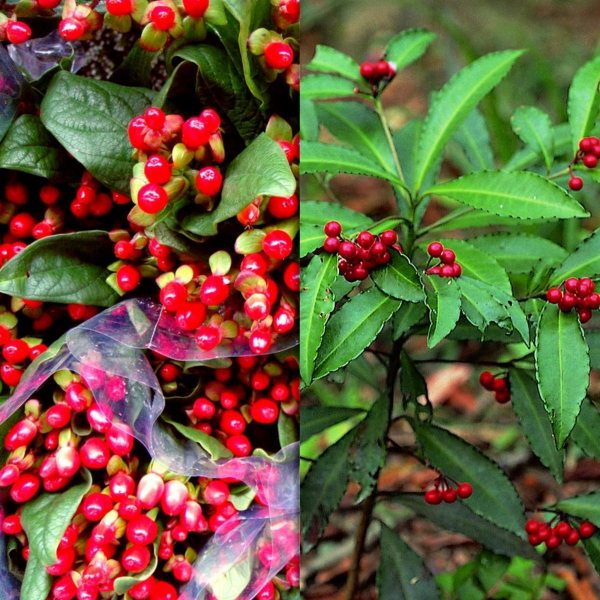

In the science of botany, this variety is called "ardisia krenata".
After flowering, if the plant is well looked after, you can see berries on it up to 1 cm in diameter. At first they have a greenish tint, then turn red and turn coral red. They resemble rowan berries in their appearance and structure. Due to this, it is also called the "coral tree". Before Christmas, the berries are the most pronounced and diverse.
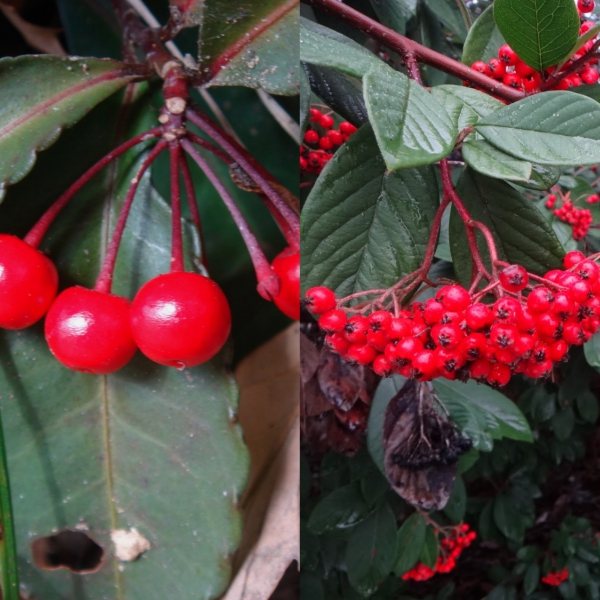

Ardisia crenata is one of a rather small number of plants that bear fruit at home. The flower propagates both by cuttings and by seeds, which may still appear in fruits that have not fallen from the plant. The plant reproduces better with seeds. The first shoots appear after about a month.
Invisible enemies of the tropical beauty
Exquisite sheet plates of indoor nightshade attract the attention of pests:
- whitefly;
- red spider mite;
- orange aphid.
Often insects settle on them, reproduce and suck out juices. The plant begins to ache and lose its decorative effect.
The miniature whitefly, which slightly resembles a moth, loves to feast on the juice of the culture. It leaves sugary traces on the leaves, and larval clutches on the back of the plate. If everything is left to chance, the leaves will begin to curl, turn yellow and eventually fall off.
Another "uninvited guest" of the flower is the spider mite. Its favorite habitats are the back of the leaf plate. Pest-caused diseases of the indoor nightshade are manifested in the formation of miniature specks on the foliage. Over time, they turn into stains that spread throughout the culture.
In a similar way, the plant infects orange aphids. It settles on the back of the plates that grow on the tops of the shoots. As a result, the foliage turns yellow and dries over time. To stop the process of crop disease, you need to get rid of pests with the help of special preparations. And then the indoor nightshade will delight the owners with its lush greenery and bright berries all year round.
Breeding methods, possible diseases and pests
The nightshade is propagated in 2 ways:
- seeds;
- by cuttings.
Get the seeds yourself from fully ripe berries. After removing from the pulp, they are washed and dried.
Sow on wet soil, sprinkle with sand. The container is covered with a light-transmitting material.
Cuttings are cut in spring or early summer. Each should have 2-4 nodes. The lower cut is deepened into a mixture of sand and peat, well moistened. The cuticle is covered with a film, which is not removed until germination.
Of the pests, spider mites and aphids settle on nightshades. Special preparations will help get rid of insects. With excessive moisture, the roots and stems of the plant can be rotted. As prevention - proper care.
The nightshade grown in the room is referred to as the unpretentious inhabitants of the window sills. But only with proper care and maintenance of the necessary parameters, spectacular bushes are obtained, which delight with a decorative look for a long time.
The nightshade plant belongs to an extensive (more than 1700 species) genus of annual and perennial plants of the Solanaceae family, widely growing in the temperate and tropical zones of South America.Among the representatives of the genus there are grasses, shrubs and trees, some of which are in demand in indoor floriculture.
Potted nightshade is a surprisingly beautiful evergreen shrub type with glossy leaves and delicate flowers, the color of which varies from white to dark purple (depending on the species). Fruits are spherical or oblong inedible berries of fiery red, orange or yellow color, giving the plant a flirtatious and cheerful appearance. At the first glance at the indoor nightshade, you will understand that the direct purpose of this radiant handsome man is to decorate the world.
We care for nightshade wisely and knowledgeably
Nightshade likes moderate watering, but does not tolerate dry air. Please note that in the summer and the dormant period for nightshade when growing in the house, different care is taken.
Did you know?
Mandrake belongs to the family of Solanaceous plants. During the Middle Ages, the plant was credited with witchcraft. The mandrake root is similar in outline to a human figure, which may be why it was most often used in love magic.
How to water your homemade nightshade
During the period of active growth and development, the plant is watered as the top layer of the soil dries up. Then gradually reduce watering, bringing it to a minimum during the dormant period (October - February). At the end of February, watering is also gradually increased and spraying begins.
Air humidity
When nursing at home, nightshade requires an air humidity of at least 60%.
When the room is too hot and dry, spray, in the summer - morning and evening. Once every seven days, the plant can be placed in a tray with damp river pebbles.
Interesting!
From the Latin name for nightshade dulcamára the charlatan doctor Dulcamara got his name - one of the heroes of Gaetano Donizetti's opera "Love Potion".
Top dressing for nightshade
During the growth period, nightshade does not need fertilization; top dressing is necessary in late spring, summer and autumn. Compositions for flowering plants, fertilizers for tomatoes are suitable as fertilizers. When carrying out dressings, follow strictly the instructions in the instructions for the preparation.
How to prune
For a beautiful formation of a compact bush, nightshade needs to be cut off. In the spring, the side shoots are cut to a third of the length, so the central trunk (base of the bush) receives more nutrients. The procedure is carried out after the appearance of the berries. In autumn, nightshade needs pruning for lush tillering, shoots that do not bear buds are pinched.
Varieties
In the tropics and some areas with a temperate climate, more than 1,700 species of saltanum grow. But we will consider only two of them, which are most often grown at home.
False Nightshade - S. pseudocapsicum. Erect evergreen shrub, growing up to 120 cm. Leaves with short petioles, oval or lanceolate, glabrous and slightly wavy.
Flowers are white, small, with five petals; fruits are round, red or yellow up to 1.5 cm in diameter. Originally from about. Madeira For indoor cultivation, undersized forms of decorative nightshade were bred.
Pepper nightshade - S. capricastrum. Much smaller in size than pseudo-pepper, it has smaller berries and more tender shoots, green with a grayish tinge. At home - in Uruguay and southern Brazil, grows in forests. The most popular varieties are Craigii - with colorful fruits and Variegatum - variegated variety.
What difficulties do flower growers face?
Subject to the rules of care, nightshade feels good in indoor conditions. However, certain problems can arise during cultivation.
Leaves fall
Perhaps the problem is a lack of moisture. The problem is especially relevant in the heat. This can also happen with excessive watering, when the roots begin to rot.
Berries fall
If the nightshade began to fall off at the wrong time, it lacks light and moisture. It is worth moving the pot to a place where there is more light and spray it more often.
No ovaries
The reason is that no pollination took place. You can do this yourself with a soft-bristled brush. Flowers are naturally pollinated only outdoors.
Spider mite
This pest affects many indoor plants. Its appearance is determined by the formation of small cobwebs on the foliage and dark spots. The plant begins to dry out gradually. To eliminate the problem, the foliage is sprayed with chemicals (Decis, Phosbecid), alternating with a soapy solution.
Whitefly
The parasite is detected by the accumulation of small insects with wings on the back of the leaves. When you shake the flower, they fly up. To eliminate whiteflies, spray with 1% Pegasus. Instead, you can take an infusion of onions.
For nightshade to show itself in all its glory, not so much is needed. The main thing is to adjust the intensity of watering in different seasons, and provide the flower with light. In order for it to retain its beautiful shape, the shoots are periodically pruned.
With proper care, the plant will delight with orange cherry-like berries and a scattering of flowers.
We watch a video about growing decorative nightshade at home:
In the windows of our flower shops, you can see green bushes with bright orange-red berries the size of cherries. This plant is called nightshade. In Europe, it is very often used to decorate houses for the Christmas holidays: bright berries contrast sharply with dark green leaves and create a cheerful festive mood.
Nightshade care
Temperature conditions
... The plant thrives best in moderate temperatures with cool nights. During fruiting, keep the ornamental nightshade at a temperature of about 16 ° C. The increased air temperature shortens the life of the plant. The temperature of the content should be 10 - 15 ° C. Do not expose the plant to temperatures below 10 ° C, as it may shed its leaves.


Indoor nightshade - lighting
... The plant loves sunny conditions, especially during fruiting. For elevated temperatures, shade the plant or keep the pots shaded to avoid overheating the roots. Rotate the plant pot ¼ turn each week to keep the nightshade growing symmetrically.
Nightshade at home - how to care
... Shoots that are too long can be cut 2/3 of the length to maintain a compact shape in late spring, but do not remove many branches at once. During the warmer months, nightshade will appreciate being outdoors. Pinch the tips of young shoots regularly for better branching.
Substrate
... For soil, use a soil mixture, for example, 2 parts of humus to 1 part of perlite or coarse sand, the pH is slightly acidic.
Growing nightshade - feeding
... Approximately every 2 weeks from the beginning of flowering to ripening, the fruits are fed with liquid fertilizers for growing tomatoes.
Appointment
... A beautifully flowering plant that looks even more spectacular during the fruiting period.
Flowering time
... In good conditions, it can bloom at any time of the year; at the same time, both flower buds and ripe berries can be found on the plant.
Air humidity
... Indoors, you must use a humidifier, or spraying with soft water at room temperature. You can also place the plant pot on a tray with damp pebbles to increase moisture.
Nightshade at home - watering
... Watering is abundant during the growing season, the soil should not dry out more than 3 cm deep between waterings during the growing season. In the fall, allow the substrate to dry out until the next watering.
Transplant nightshade
... Transplant young indoor plants aged 2 to 3 months into larger containers. Try not to damage the earth ball when transplanting. During the first week after transplanting, the plants are not fed. Adult specimens are transplanted approximately every 2 years.
Breeding nightshade
... With seeds, sprinkle them with a thin layer of soil - just enough to barely cover the seeds, the germination period takes 2 - 3 weeks. Keep the soil evenly moist. Make sure the soil surface does not dry out until the seeds germinate. The germination rate of fresh seeds reaches 100 percent. You can place the seed pots under a plastic cover, leaving a gap for fresh air to enter. Keep the pots warm at about 18 - 24 ° C, but not higher. Avoid direct sunlight for the first 4 to 6 weeks.
Indoor flowers are a great decoration for any home. This is the best option for a variety of interior. The presence of indoor plants ennobles the home and makes it cozy. Solanum, popularly known by the name of indoor nightshade, indoor cherry, Chinese cherry, coral bush. This is a bright berry-leafy composition with red berries that look like a ball.
Solanum (indoor nightshade) is small evergreen bush
from the Solanaceae family, densely covered with leaves and bright orange berries. It appeared in our latitudes relatively recently. Most common in South America, Australia, Peru, Madeira.
The attraction lies mainly in its bright berries, which are indeed cherry-like, but very poisonous.
Unfortunately, this plant does not live long. But on the other hand, throughout his life, he pleases the eye with variegated fruits. It blooms regardless of the season, but the berries last for a very long time, up to several months. And they do not lose their brightness and attractiveness.
Propagation of nightshade by cuttings
At home, nightshade can be propagated by cuttings. They are rooted in a mixture of peat and sand at a temperature of 22-25 °. To create a greenhouse effect, the container is covered with foil. In conditions of high humidity, rooting takes place much faster.
As soon as the cuttings start growing, the film is removed. To form dense, fluffy bushes, the plants are pinched 3-4 times. All parts of the nightshade are poisonous, therefore, when working with it, you must use rubber gloves.
What conditions are optimal for nightshade
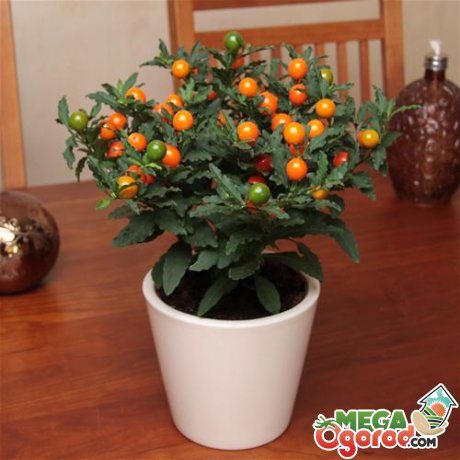

It should be remembered that decorative nightshade is a plant from the tropics, so the conditions of detention should be as close as possible to natural ones. The plant requires constant spraying and maintaining an optimal temperature, which is lowered for the winter.
Also, the flower is quite photophilous, but categorically cannot stand direct sunlight.
If the flower doesn't like something, then it will notify about it:
- dropping leaves, which means that the plant lacks light
- poor flowering and small fruits - about insufficient heat
- curling leaves - about an excess of sunlight
- drooping sluggish leaves - about poor watering and a hot place
- shrunken berries - about a lack of moisture in the soil
- dull leaves - about lack of nutrition
The humidity level should always be high and not fall below 60%.
Growing problems?
The houseplant nightshade rarely causes trouble for its owner, only with improper care can it suffer from excess or deficiency of moisture, and be attacked by pests.


- If nightshade doesn't bloom ...
This is the most common problem that causes frustration! For the formation of flower stalks, nightshade needs constant bright light throughout the year. Without light, the flower stretches out, does not form buds and sheds the lower leaves. The nightshade plant does not like stuffy rooms with dry air, in such conditions flowering does not last long, the fruits are not formed, and the existing ones quickly fall off.
The flower prefers late winter transplantation and pruning, this stimulates flowering, and pollination is required for fruit to set. It occurs fastest in the air, so for the summer season it is better to place the flower on the balcony, or take it out into the garden.If flowering occurs during the period of "home stay", you can limit yourself to airing, or try to artificially pollinate with a brush (applying pollen from one flower to another).
- If nightshade sheds leaves ...
This can occur from overflow, but more often the reason is a lack of light, especially in winter, in combination with dry air, salt can lose half of the foliage. Leaf fall is the result of damage to the roots during transplantation, or after unsuccessful watering, hypothermia, or overdrying.
Indoor nightshade sometimes mope in dry air, but it is worth remembering that leaves can also crumble as a result of the activity of a spider mite. In this case, they curl up one by one, turn yellow and fall off. Therefore, periodically examine your "ward" and give him a warm shower. "Pests of indoor flowers: diagnostics". So that the "bald" nightshade grows more quickly with new foliage, you can create greenhouse conditions for it by placing it under a transparent bag and maintaining moderate humidity.
- Spots on nightshade leaves ...
The nightshade flower forms spotty leaves from a lack of trace elements: iron, magnesium, nitrogen. Sometimes for this reason, the leaves lose their color, become pale. The situation can be corrected by root dressing, as well as leaf dressing with magnesium sulfate. The second dangerous cause can be the development of diseases, fungal, or bacterial (especially if the stain is wet, or there is a plaque). Signs of "plant" diseases.
Nightshade indoor care, which is described above, will become the pride of any florist. Now you can also try to grow a fruit plant on the windowsill.
Support our site, share the link on social networks. Thank you!
An amazing plant with which you can create an exotic green corner is indoor nightshade. Its main decoration is fruits. It is they who give the bush a chic and elegant look. The appearance of berries among the rich greenery resembles a spruce, decorated with bright balls. Why not give yourself such a cute flower and admire its beauty? Let's take a closer look at the exquisite berry mosaic on the window.
Reproduction and planting of a plant
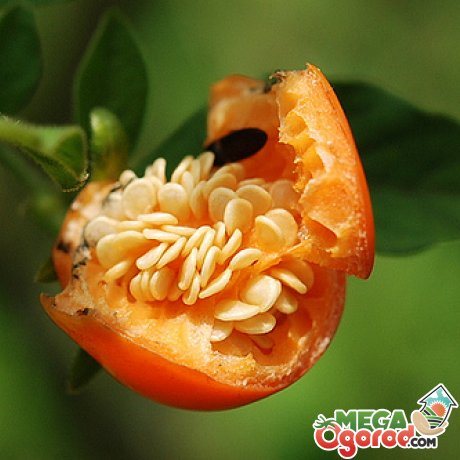

Indoor plant propagation can be carried out by seeds and cuttings:
- When planting seeds, leafy soil is most suitable, on the surface of which the seed is laid out at a distance of 2 cm from each other and sprinkled with sand. The container is placed in a warm place for germination, creating greenhouse conditions with a film cover. The seeds will sprout within 10 days. The bores in the first stages grow very intensively and therefore they need to be dived, and this procedure is carried out twice. This is necessary to give the future bush a compact spherical shape. After the second pick, the plant can be planted in the ground.
- The propagation process with cuttings is a faster process. Cut twigs are used as cuttings. It is easiest to root the cuttings in a sand-peat mixture, and when a sufficient number of roots are formed, transplant the plant into a suitable soil. With proper care, flowering and fruiting is possible in young flowers.
The development of nightshade and the size of its berries depend on the breeding method. When propagated by seeds, the plant grows longer, but stronger and bears fruit actively. When grafting nightshade takes time to adapt and the fruits of the former are small, and flowering is poor.
The optimal soil for nightshade is a mixture of peat and clay soil in a ratio of 1: 3 with the addition of a small amount of sand. At the bottom of the planting tank, it is imperative to place expanded clay or crushed stone drainage; small brick fragments are also suitable.
Nightshade varieties for home cultivation
In room culture, the following varieties of nightshade are most common:
- Pepper.It is a shrub 50 cm in height. The leaves remain on it all year round and are of different sizes. The shape of the plate is elongated, and the edges are wavy. In June-August, rare white flowers appear on the nightshade. After flowering, red fruits are formed in their place - berries up to 2 cm in diameter. This type of nightshade is poisonous.
- False-transverse. One of the most popular nightshades. Its height also does not exceed half a meter. It differs from pepper in more saturated green leaves. Its rounded small berries can decorate the bush all year round. It blooms with white flowers, and the fruits can have red, orange and green hues.
- Curly. Its flowers resemble garden potato inflorescences. This evergreen plant has climbing shoots, therefore it is also called a liana. In the warm season, it is quite suitable for growing outdoors or an unglazed balcony. This species of nightshade grows very quickly.
There are several other types of nightshade that are very popular with flower growers - "giant", "jasmine", "Wendland", "Zeafort". They are highly decorative, but can grow up to 4-6 meters, therefore they are grown in greenhouses.

